The ASUS Maximus VIII Extreme Review: The Other $500 Option
by Ian Cutress on April 7, 2016 9:00 AM EST- Posted in
- Motherboards
- Gaming
- Asus
- ROG
- Skylake
- Z170
- Thunderbolt 3
System Performance
Not all motherboards are created equal. On the face of it, they should all perform the same and differ only in the functionality they provide - however this is not the case. The obvious pointers are power consumption, but also the ability for the manufacturer to optimize USB speed, audio quality (based on audio codec), POST time and latency. This can come down to manufacturing process and prowess, so these are tested.
Power Consumption
Power consumption was tested on the system while in a single MSI GTX 770 Lightning GPU configuration with a wall meter connected to the OCZ 1250W power supply. This power supply is Gold rated, and as I am in the UK on a 230-240 V supply, leads to ~75% efficiency > 50W, and 90%+ efficiency at 250W, suitable for both idle and multi-GPU loading. This method of power reading allows us to compare the power management of the UEFI and the board to supply components with power under load, and includes typical PSU losses due to efficiency. These are the real world values that consumers may expect from a typical system (minus the monitor) using this motherboard.
While this method for power measurement may not be ideal, and you feel these numbers are not representative due to the high wattage power supply being used (we use the same PSU to remain consistent over a series of reviews, and the fact that some boards on our test bed get tested with three or four high powered GPUs), the important point to take away is the relationship between the numbers. These boards are all under the same conditions, and thus the differences between them should be easy to spot.
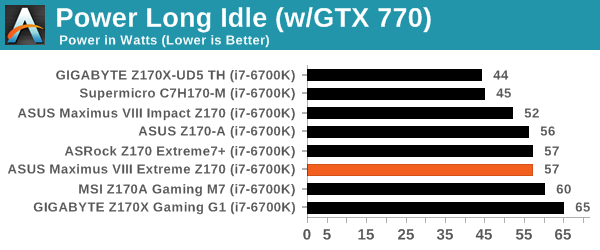
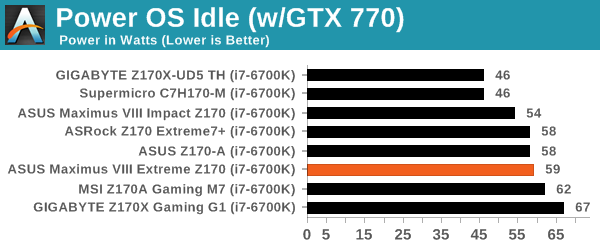
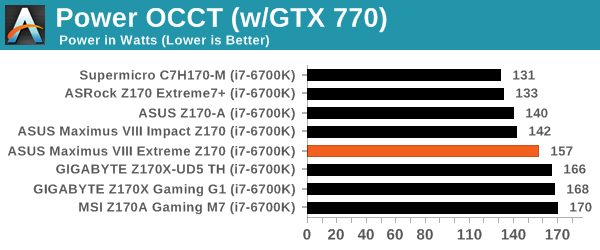
By the nature of being a large E-ATX motherboard with a number of extra controllers, one would expect the M8E to draw a fair bit of power, even under CPU load.
Non UEFI POST Time
Different motherboards have different POST sequences before an operating system is initialized. A lot of this is dependent on the board itself, and POST boot time is determined by the controllers on board (and the sequence of how those extras are organized). As part of our testing, we look at the POST Boot Time using a stopwatch. This is the time from pressing the ON button on the computer to when Windows 7 starts loading. (We discount Windows loading as it is highly variable given Windows specific features.)

Perhaps due to the emergence of Windows 10 and fast boot sequences, fewer motherboard companies are worrying about POST times, although they are now arguably the longest part of a start-up process, especially with the additional DDR4 training needed for validation. The Extreme is reasonably comfortable for its size at 16.50 seconds.
Rightmark Audio Analyzer 6.2.5
Rightmark:AA indicates how well the sound system is built and isolated from electrical interference (either internally or externally). For this test we connect the Line Out to the Line In using a short six inch 3.5mm to 3.5mm high-quality jack, turn the OS speaker volume to 100%, and run the Rightmark default test suite at 192 kHz, 24-bit. The OS is tuned to 192 kHz/24-bit input and output, and the Line-In volume is adjusted until we have the best RMAA value in the mini-pretest. We look specifically at the Dynamic Range of the audio codec used on board, as well as the Total Harmonic Distortion + Noise.

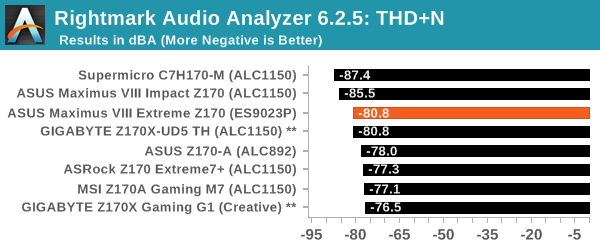
Audio performance from the Extreme gives it the highest SNR of any 100-series motherboard we’ve tested before.
USB Backup
For this benchmark, we transfer a set size of files from the SSD to the USB drive using DiskBench, which monitors the time taken to transfer. The files transferred are a 1.52 GB set of 2867 files across 320 folders – 95% of these files are small typical website files, and the rest (90% of the size) are small 30 second HD videos. In an update to pre-Z87 testing, we also run MaxCPU to load up one of the threads during the test which improves general performance up to 15% by causing all the internal pathways to run at full speed.
Due to the introduction of USB 3.1, as of June 2015 we are adjusting our test to use a dual mSATA USB 3.1 Type-C device which should be capable of saturating both USB 3.0 and USB 3.1 connections. We still use the same data set as before, but now use the new device. Results are shown as seconds taken to complete the data transfer.
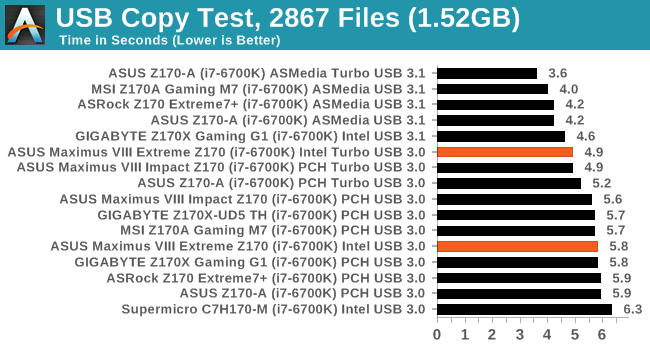
With ASUS’ USB Turbo, we get great performance in our USB 3.0 test. Unfortunately due to the nature of the Intel USB 3.1 controller, our testing software reports erroneous results stating that a transfer is complete faster than could be possible (and it’s a highly variable result). Interestingly we also had problems with the ASMedia controller, which behaved similarly.
DPC Latency
Deferred Procedure Call latency is a way in which Windows handles interrupt servicing. In order to wait for a processor to acknowledge the request, the system will queue all interrupt requests by priority. Critical interrupts will be handled as soon as possible, whereas lesser priority requests such as audio will be further down the line. If the audio device requires data, it will have to wait until the request is processed before the buffer is filled.
If the device drivers of higher priority components in a system are poorly implemented, this can cause delays in request scheduling and process time. This can lead to an empty audio buffer and characteristic audible pauses, pops and clicks. The DPC latency checker measures how much time is taken processing DPCs from driver invocation. The lower the value will result in better audio transfer at smaller buffer sizes. Results are measured in microseconds.

For better or worse, DPC Latency has been a wild ride on Z170. Some companies care deeply, others are not too fussed. Despite this, ASUS seems to have nailed down the formula for a great DPC Latency, and the Maximus VIII Extreme takes the crown from its smaller sibling in style.










70 Comments
View All Comments
Shadowmaster625 - Thursday, April 7, 2016 - link
$500 for +1% fps? Sounds like a really smart buy.extide - Friday, April 8, 2016 - link
No... that's not why you buy this board...Gunbuster - Friday, April 8, 2016 - link
Same as $700 phones when a $200 or even $30 handset does the job 95% as well...Gastec - Thursday, September 22, 2016 - link
But if the phone is gold plated and encrusted with diamonds it does the job A LOT better. Now I dare you to name the job ;)dreamcat4 - Thursday, April 7, 2016 - link
Given that this ASUS board has no PLX chip, might as well get the ASRock Z170 OC Formula instead. It doesnt have the Alpine Ridge / TB3, or the 3x3 Wifi. But then few people use such things anyhow.It seems no review of the OC Formula here because at the time it wasnt out yet, and also because you reviewed the ASROCK Extreme 11 instead... yet the OCF is a great board.
dreamcat4 - Thursday, April 7, 2016 - link
... Extreme 7+ was what I meant to say at the end there.extide - Friday, April 8, 2016 - link
Yeah the Asrock Z170 Extreme 7+ is my fav Z170 board out right now. Dual (good) nic's, 3 m.2, no other extra BS, reasonable price, etc etc.HideOut - Thursday, April 7, 2016 - link
There are no new astons for under 100K, not USD. You might find a stripped one for less than 100K British pound, but since you referenced USD thats a no go.HollyDOL - Friday, April 8, 2016 - link
Ok... and now somebody could make a mobo for me:2x U.2 NVMe + 6x SATA-3 (able to run all 8 ports simultaneously, SATA-3 needs to be able to run RAID-5 or 5e)
No wifi, no integrated sound (waste of cash for me)
integrated Intel NIC (1Gbps+)
2+ USB 3.1 type C ports
6 USB type A ports (2 of those USB3.0)
4x DDR4
1xDisplayPort, 1xHDMI 2.0
3-4 PWM for fans (ideally at least one powerful enough to drive water pump)
2x PCIe 16x (can be in 8x/8x mode)
1x PCIe 4x
1-2x PCIe 1x (one should be sound card low latency friendly)
LGA 1151
That would fit exactly my requirements for currently ideal mobo.
extide - Friday, April 8, 2016 - link
Best bet is the ASRock Z170 Extreme 7 -- it has 3x M.2 ports which you can get the adapters and convert them to U.2 -- there are no boards out with more than one U.2 built in right now.Also, can't believe there is SATAe on this board. WHEN WILL IT DIE!!